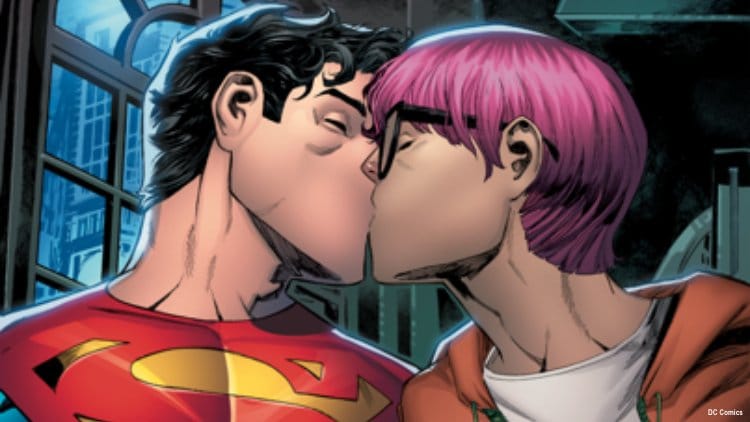Editorial Note: Ok, first and foremost, and I hate that I have to do this every time when speaking about LGBT anything. We here at The Outerhaven are supportive and acknowledge the LGBT community and the struggles that they face (apologies if I’m missing letters, there are too many to always keep up on for me). We do not hate any part of the community at all, with many members on the team having family and friends who are of the community or are a part of the community themselves. The following article is not an attack on them, nor the representation of them. We celebrate the fact that there are more uses of LGBT people in media when it is done right, and not done for marketing purposes as you’ll see outlined in this article.
Dateline – October 11, 2021 – Twitter calls this #ComingOutDay, another visibility day for the LGBT community, proclaiming a safe space/day for people who might be hiding their LGBT lifestyle in fear of hatred, backlash, and other negative results of proclaiming that they are Gay, Bi, Trans, etc. For those people who are “in hiding”, this is a great thing, a community showing that there is support out there for people who might need help, or that little push, to “come out” and face their truth and show it to the world.
It is on this day that DC Comics set up an interview for Superman: Son of Kal’El writer Tom Taylor with the New York Times where Taylor announced that Jonathan Kent, the SON of Superman, is coming out as Bisexual. To quote the article, Taylor said: “The idea of replacing Clark Kent with another straight white savior felt like a missed opportunity, a new Superman had to have new fights — real-world problems — that he could stand up to as one of the most powerful people in the world.”
Representation is not a bad thing. Jonathan Kent coming out as Bisexual is not a bad thing. However, there is something to be said about the timing, its relation to representation, marketing, and the current state of comic books in America today. To say that this interview release is a bit suss is pretty easy to say, but I’m here to prove that comic book companies do not really care about the characters, nor the representation they create but are using a community to drive sales in an era where this type of headline is quickly becoming over-represented and just done for clicks.
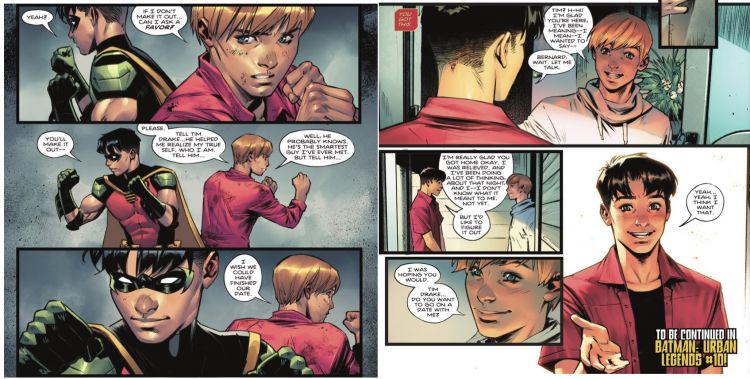
Why We Shouldn’t Be Surprised Anymore
Comic characters “coming out” is a headline grabber in this modern era. Most people (or at least those with loud voices on social media) are trying to get more LGBT representation in all forms of media, citing that the community is under-represented. To be honest, since 2015, the amount of LGBT people in media has increased manyfold. Almost weekly there is a character who is written as LGBT in television, movies, and comic books. This has been done to the point where the representation of LGBT characters has become commonplace, so much that it’s actually easier to write a list of shows with completely straight characters than LGBT characters since they are now represented everywhere… But the voice people will still claim they are under-represented.
LGBT representation in comics is nothing new, with some of the first mainstream references dating back to 1976 where a comic strip called Doonesbury introduced a character who identified as Gay, though misrepresenting the HIV issues that were troped onto LGBT people during the 1970s through the late 1990s. While the more well-known American comic books were under the Comics Code Authority (CCA), which had a ban on any LGBT content between 1954 and 1989, though this did not stop many DC and Marvel writers from illuding to the idea that some of their characters might be of the LGBT community. Once the CCA removed the ban, more and more characters were created with LGBT representation in mind.
Even more so, companies like DC and Marvel have embraced the LGBT community with not only characters, but whole books dedicated to the LGBT community, including their Pride Month issues most recently, and a pile of Young Adult Graphic Novels that feature mostly LGBT characters in starring roles like the recent “I Am Not Starfire”, which has the daughter of Teen Titans hero Starfire (Her name is Mandy) not only discovering her Tamaranian powers but also her sexuality as a Lesbian in a decently written book.
If we go back in time only 2 months ago, there was a small point in time where DC, once again, caught headlines by announcing in Batman: Urban Legends that Tim Drake, one of many Robins over the years, was a bisexual too! Oh, you don’t remember this? Well, it did appear on a lot of new websites, like New York Times and all those, and it trended on Twitter for a few days, then resulting in only 43,000 units sold for that same book. Taking a look at the recent news, no one even mentions that this happens, and Batman: Urban Legends continues to not pull in many readers after the news disappeared from news feeds and people’s minds.
Earlier in the same month, the vocal people were cheering in LGBT because Disney+ TV Show Loki showed a small image from the credits in which it confirmed that Loki was bisexual and also gender-fluid… Not really a shock to those who actually know or researched Norse Mythology and “got educated” in Loki’s background.
Back in the world of comics, a lot of fans will know of Northstar, an X-Men character who is known as the first comic hero to “come out” as LGBT all the way back in 1992. Over the many years, and versions, that Northstar has appeared since that time, he has always been seen as Gay, complete with having relationships with other X-Men characters which has been known as heterosexual (or “cis” in current terms) like Colossus. Northstar also caused major headlines all over the world with Astonising X-Men Issue 51, which featured Northstar and his partner Kyle Jinadu, getting married in the first-ever same-sex marriage in comic book history in 2012.
The point at this stage for long-term comic book fans is that representation of the LGBT community is nothing new, with some comics doing more for the progression of LGBT rights than people in the real world have done from behind their keyboards and computer screens. Over the past 5-6 years alone, we have had so many characters being created as LGBT people or updated to be included in the community that it is no longer something that we should be surprised with at all.
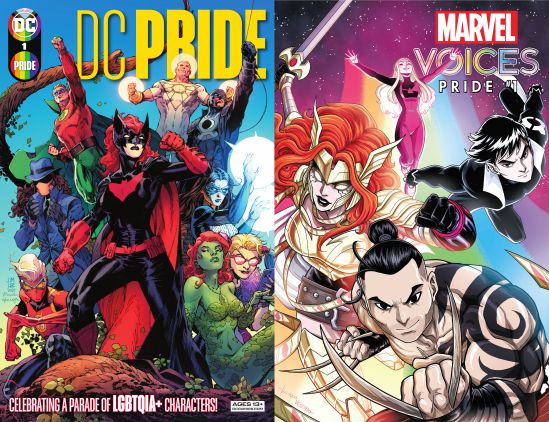
Comic Companies Are Pandering
After writing all of the above, I’m going to state this: COMIC BOOK COMPANIES DON’T CARE ABOUT THE LGBT COMMUNITY, THEY CARE ABOUT YOUR MONEY.
At the moment, things like LGBT representation and other diversity topics are being seen everywhere in social circles. With the advent of places like Twitter and other social media, people have become more aware that there are more layers and requirements for the LGBT community to integrate with bringing it into their own community. News media spends many hours each week talking about which celebrity is coming out, which characters are coming out, making sure that LGBT people play LGBT characters, etc. The outpouring on social media for the same topics is tenfold to that of the media, leading to LGBT topics trending in both their own community and the wider social community too.
So what does a company see when they notice that LGBT issues are requirements are trending on something like Twitter? They see MONEY. If something is going to bring them attention, then they are going to turn it into a marketing tool and do whatever they can to chase the trends in order to make sales.
If you notice a few things about the Jonathan Kent announcement, it happens to fall on what Twitter has dubbed #ComingOutDay. I mentioned how I like and support the idea of #ComingOutDay, I will also point out that it’s a bit suspect that DC Comics has used this day to promote the announcement. Some people might see it as something that is right to do given the idea of the day, but when a huge company like DC Comics (Currently owned by Warner Bros Media) decides to co-opt the day to promote a character and a product because they can see a way to integrate themselves into the day for nothing short of business means.
This isn’t the first time DC Comics, nor Marvel, have used special days or months to sell products under the guise of propping up LGBT/Diverse voices. During International Woman Month, both companies put out comics that were dedicated to female characters, written by female writers. Then again during Pride Month, both companies did the same thing, with the focus being on LGBT characters and writers. However, during the rest of the year, you will not see anything to do with those characters in terms of showing pride in themselves and their sexuality, unless the book starts dropping in sales.
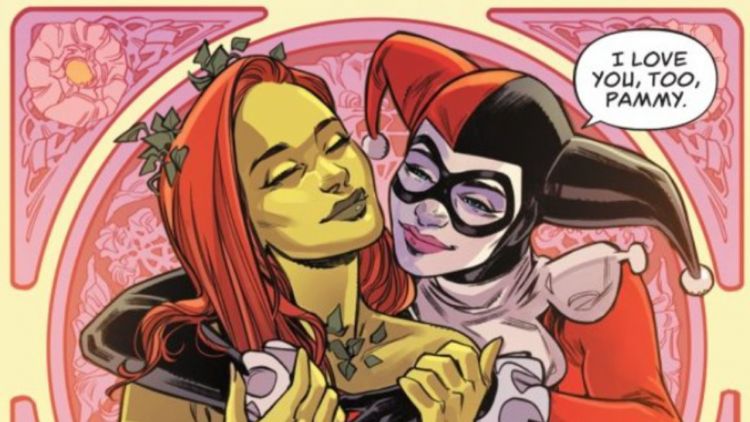
There Are Bigger Names Who Do Representation Better
There are many characters out there already who are a part of the LGBT community, and to be honest, have created much better stories than anything most modern writers have done with their forced character changes and storylines. The biggest and best example has been Harley Quinn and Poison Ivy. Pretty much from her inception, Poison Ivy has been seen as a bisexual woman, with relationships involving both men and women throughout many comics and other media. By embodying the idea that nature loves everyone, and Poison Ivy being that embodiment of nature’s will, also loves anyone. It’s an amazing idea and really set Poison Ivy out as a pillar for the LGBT community. Unless provoked, Poison Ivy is a very loving person and is shown as a peaceful person in her personality, a great example of how we can be as humans in general, but with an LGBT twist.
Then you have Harley Quinn, an abused girlfriend of The Joker, who finally had enough of his bullshit and walked away from him. However, during her time as a henchwoman/girlfriend for The Joker, we saw Harley spend a lot of time with Poison Ivy (and Catwoman, another LGBT character) when she and Joker were on the outs. To say that people of all kinds loved the idea of a Harley and Ivy pairing that it was seen not only in Batman: The Animated Series (where Harley was first seen) but also in comic books over the years. Of course, during this era, it was the time of the “headcanon” or fan fiction trope, where people online would pair up (mostly same-sex) characters into romantic relationships when nothing was written in official media. The pairing of Harley and Ivy was so popular, that a few writers of Harley Quinn flirted with the idea of her being bisexual, leading to teasings of a romantic relationship between the bat swinging lunatic and her plant-based bestie.
The true idea of the romantic relationship between Harley and Ivy was not explored to its full extent until the New 52 Reboot in 2011, featuring Harley’s second ongoing series (and to be honest, the best-written series of the 4 solo series Harley has had) where we would see more leanings into the pairing, finishing with the two getting together more than a few times throughout this series and the following ones. The full culmination of the two would not happen till more recently, in the Harley Quinn animated TV series, we finally see Harley and Ivy admit their true feelings to each other, end up together, and are chased by police into their happy ending. This had carried over into more recent Harley and Ivy stories, where the two are together romantically, expressing their feelings for each other openly… As it should be.
The difference between this coupling, and the more recent Tim Drake and Jonathan Kent outings is that we had something that had progressed naturally, with many writers agreeing to what this means to both characters, building up the relationship over time and allowing the fans to either accept it or move on from the books. What we see with this New York Times interview is that it was done in the same vein as Tim Drake, and even Bobby Drake (aka Iceman), where the “revelation” comes completely out of nowhere, has no build-up, and essentially no chemistry. Not to mention that the way it is announced and marketed, the design is more of a “Accept this or you’re a homophobic sexist” nature, where either you agree with this or you’re going to be torn into by the LGBT community defenders and “allies”.
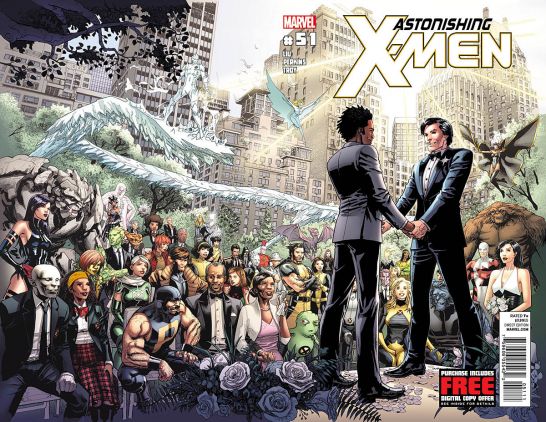
Over 150 LBGT Comic Characters
Since the early 2000s, comic companies like DC and Marvel have had a positive outlook and freedom to either make new LGBT characters or to update legacy characters to be in LGBT standing in their sexuality. Over the past 20+ years, DC comics have created or updated 88 characters to be in the LGBT community, with Marvel lagging behind a bit at 65 characters. A total of 153 LGBT characters are in comic books today, and not all of them are minor names in the franchises.
While they might not have been some of the first characters to come out in comics, characters like Wonder Woman, Kate Kane (Batwoman), Catwoman, John Constantine, Tim Drake (Robin/Red Robin), Renee Montoya, Lucifer Morningstar, Poison Ivy, Harley Quinn, Black Cat, Black Widow, Daken, Deadpool, Hercules (both in comics and Greek mythology), Iceman, Mystique, Kitty Pryde, Psylocke, Red Sonja, Shatterstar… All big-name characters who are in the LGBT community that no one blinked an eye about when they came out. Why? Because, unlike today’s headline-grabbing, trend-seeking society, those characters didn’t have nor need a huge celebration when they came out, they just said they were LGBT and went straight back to kicking ass and being heroes/villains.
LGBT characters might not dominate the landscape of comic books, and that’s something that doesn’t need to happen, but the representation is there. While this should account for something, if you look on social media, you’ll see that this is never enough. Having big names attached to the LGBT community doesn’t seem to be enough for the vocal people on Twitter, so having “Superman” in their ranks comes off as some sort of big win. As Glen Weldon, the author of “Superman: The Unauthorized Biography,” said in the New York Times article: “It is not Northstar, who your aunt has never heard of. It’s not Hulkling. It’s not Wiccan. It’s not Fire and Ice. It’s not Tasmanian Devil. It is Superman. That counts for something — just in terms of visibility, just in terms of the fact that this is going to attract attention.” While this is very misleading, this is what people want: To find a way to bring the biggest and most attention to their community by any means.
While there are plenty of big and very well-known names under the LGBT flag, it seems that a lot of vocal people only care about what the latest headline is about, not the generations of representation that are already available and well known in the industry. This idea really sucks as it keeps up LGBT people as victims and downtrodden communities, which in reality, have been accepted and celebrated for many decades. As always, a vocal minority hurts the greater community and keeps companies using them to get attention for products rather than real issues facing the community.
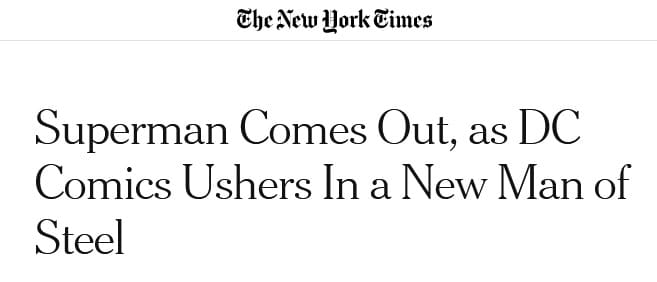
New York Times Misleads With Their Headlines
As you can see above, this is the exact headline that the New York Times used when publishing this story. Now, in their defense, the subheading did read “The new Superman, the son of Clark Kent and Lois Lane, is concerned about the environment, does not shy away from politics and will soon begin a romantic relationship with a male friend.” so that you do get the correction to the statement once you’ve clicked the article. However, the main headline reads in such a way that it sounds like after decades of being married to Lois Lane, that Clark Kent has come out as gay. This was designed, by nature, to make you think this and either be outraged or come to celebrate what would have been a milestone in comic book history… But you’ve been misled.
Remember, as Glen Weldon said: “It is not Northstar, who your aunt has never heard of… It is Superman. That counts for something — just in terms of visibility, just in terms of the fact that this is going to attract attention.”
If it was in fact Clark Kent, the man who is Superman (no matter what DC Comics marketing wants you to think), who came out today saying that he has been gay or bisexual for the past few decades and only felt strong enough to come out today, then I’d be one of those people cheering it, standing alongside my LGBT friends showing my support that one of the most recognizable names in comic books has joined their ranks, and this article would not exist. However, this is not the case.
What we got instead was a somewhat new character, who for some reason went from the age of 10 to 17 (Yes folks, Jonathan Kent is 17 at this current point in time) for no reason other to try and push him into the Superman slot as DC Comics looks to do what Marvel has been trying to do for years by replacing an older superhero with a recognizable and easy to bank on brand behind them with a younger, and more diverse, character for them to try and appeal to the new generation (Most of whom, while cheering this move, won’t buy the books). The American comics industry is dying as more older and younger readers are turning to Manga and fan comics instead of buying these generations-old superhero books, so the companies are doing anything they can to appeal to this market as much as possible, turning their backs on old readers, many of whom are still buying physical comic books, in favor of a generation who couldn’t even sit through a 3 minute TikTok let alone buy and read a physical comic book.
But I digress… The New York Times article does a good job in getting to the actual story once people click and read the article, however, the problem is that a lot of people are not going to read the article, or give NYT the click and ad revenue, only reading the title. People are sick of misleading headlines, so instead of reading about a newer hero coming out, they go on the fact that the NYT article clearly states that it’s “Superman” who has come out, and get outraged that this decision has been made. But that’s the point, the media industry doesn’t seem to care about the content they are putting out but generating outrage so people will share and retweet their article so others can click it and read it.
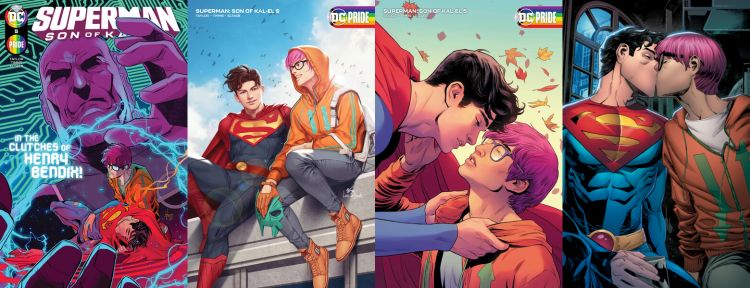
It’s All A Marketing Stunt
Superman: Son of Kal’El (Another title that misleads the public) is only a book that is a few months old. The first issue was published in July 2021, to a very average sale of 68,000 units, making it the 17th most bought book in the month. For the month, 68,000 books sold isn’t a huge deal. The entry barrier for the top 10 books being somewhere in the 90,000 unit sales. But that was the first issue, and like most first issues, are prone to the “speculation boom” where people will buy any first issue of a series with the sole objective to keep the book in their collection to sell off later for a profit if the series takes off… Superman: Son of Kal’El is not one of those series.
The latest sales figures, August 2021, have shown that Superman: Son of Kal’El has dropped from 17th to 56th in the monthly rankings, with a very bad 40,000 units sold. Going from 68,000 to 40,000 might not seem like a huge drop, but 28,000 books are over a third drop from issue one to issue two. Plus if September’s advance reports are to be believed, then Superman: Son of Kal’El is either going to drop even more, or stagger in the 30,000-40,000 range.
The point is that this book is not selling, and for something that DC Comics has put a lot of time and effort into marketing and pushing Jonathan Kent as the new Superman, this first solo outing selling around the same as the last issue of Clark Kent’s Superman run (Issue 32: June 2021 – 32,000 units sold), and the dying sales of Action Comics (31,000 units sold each month for the last 6 months. These issues also feature the set up for Johnathan taking over as Superman… Coincidence?) really doesn’t look good for business.
So how would DC Comics prop up sales on a dying book featuring an idea that people are not agreeing with? Well, you drum up some headlines in the media with a move that looks controversial and can cause discussion online and create trends in the social sphere. We’ve seen this idea done many times over the decades, from the Death of Superman/Captain America/Spider-Man to the use of a character’s race to promote sales (Miles Morales, Gavin King, Tim Fox, Sam Wilson, etc), or gender swap the lead (Spider-Woman, Jane Foster as Thor, etc), and other stunts designed to help push new books into the hands of readers. The latest version of this is the “coming out” of a character to see if the LGBT community will come to join the ranks of comic book readers… Sorry folks, but that community doesn’t want to join for they have their own stories that they want to read away from the mainstream comic publishers.
Not to mention the timing of DC Comics co-opting a day where people should be safe to have their coming out moment and getting the love and support from all communities that they deserve. #ComingOutDay is meant for people in or entering, the LGBT community to express themselves in a safe space. Instead, all we have seen in this day in the news, and the hashtag, are stories and conversations about Superman being outed. DC Comics has knowingly hijacked a day meant for the LGBT community to come together, and other communities to join them, in order to push a product that they have slapped the LGBT title onto just to sell it and save it from cancelation.
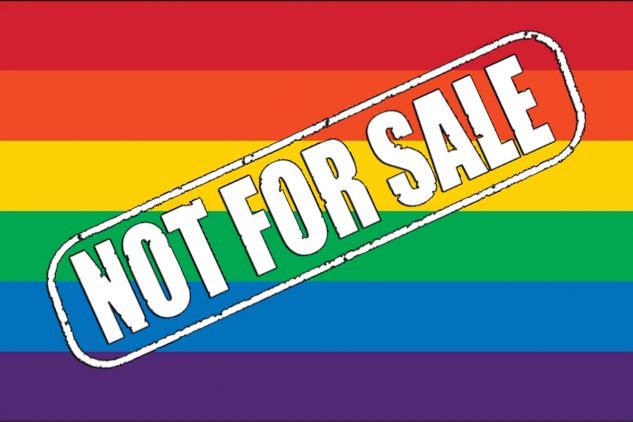
The LGBT Community Is Not A Product To Sell
In closing, I would like to start by apologizing to the LGBT community. I’m sorry that a company like DC Comics sees you as nothing more than a brand, a label to place on a product when sales are failing. I’m sorry that your safe space, and day, was hijacked by a company looking to make a profit using your way of life. I’m sorry that you are pushed into the shadows on a day when your pride should shine. I’m sorry that the media treats your community as a headline to generate clicks and ad revenue. I’m sorry that you have been denied the chance to speak your truth, and are instead forced to defend a decision that was never made to boost your lives or community.
This article is not, in any way, meant to cause offense to the LGBT community. When I see stories like this Jonathan Kent story, I get angry. For when I see this I see my friends in the LGBT community, including a great bisexual woman whom I consider my adopted sister, being used as a marketing tool by a company that couldn’t care less about them as people, but instead only see them as walking wallets, or trends on Twitter, or a gimmick to push sales.
The LGBT community is not something to be sold, marketed, or used to grab clickbait headlines. The LGBT community is full of amazing and loving people who are more than who they choose to sleep with or identify as. They are first, and always, people to me. I support and love all my LGBT friends and family, and hope that one day the rest of the social media sphere, media, and companies would see this topic as an outdated and unneeded topic as everyone is accepted for who are they in their hearts.


